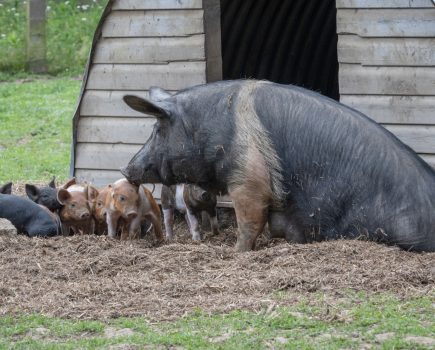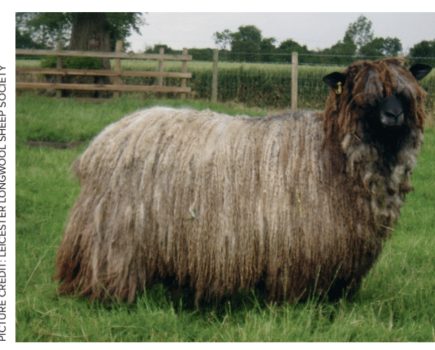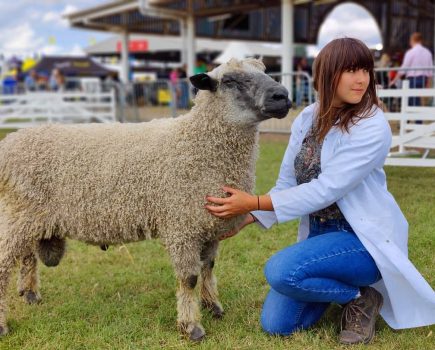Choosing the right male will affect the value of your goats’ offspring and the quality of your herd. Anke Sieker offers advice
With autumn here, it is getting noisier in the goatshed – the females are coming into season. Most goatkeepers will have thought about their next generation of kids since the late summer and made arrangements to get their girls mated. Unfortunately many smallholder goats are mated by the ‘boy down the road’, with no serious thought on the value of the offspring or herd quality in general. Who is the right billy for my goats? I have been sucked into showing my goats and pedigree breeding. I spend a lot of time looking through male pedigrees, and talking to their owners to make sure I can use the right male for my girls. However, even if the main aim is to just provide milk for the house from a couple of nannies, a well-bred kid from a quality sire should recoup the breeding costs. The British Goat Society list of distinguishing signs and awards for males is complicated. In general a male with a couple of numbers in front of his name indicates good milk production in his ancestry, which hopefully will also translate into his offspring. Actually seeing the male, or even better his daughters at shows or directly on the farm, would be ideal. Other features to look out for are general conformation, sound feet, a good long body and correct mouth. Udder shape on his daughters is also important. If there is no market for dairy type kids, perhaps using a meat sire (for example a Boer billy), would allow the raising of kids for meat rather than milking. So what are the options? Travelling to a stud billy The majority of small scale goatkeepers do not keep their own billy, and therefore have to plan their mating season with military precision. The females come into season every three weeks. By noting the first season of the year, arrangements can be made for 21 or 42 days later. It would not only be courteous to the stud owner to enquire about the male’s availability well in advance of the autumn, but also to give him/her a three-week notice. Movement restrictions can create a difficult situation if several goats come into season in quick succession. It is sometimes hard to spot a female in season, especially early in autumn and when no males are nearby. This is where a ‘billy rag’ comes in very handy. This is any old piece of cloth that has been rubbed down on a ‘billy in full aroma’, sealed in a plastic bag for storage and given to a nanny to sniff if it is suspected that she may be in season. If yes, her tail wagging will confirm this beyond doubt. If not, she will just try to eat it. I have had my billy rags posted to me from stud owners, double wrapped in plastic and then in a jiffy bag. So far I have not been struck off the Royal Mail delivery service…. Sponging the ladies The use of progesterone sponges to compact the lambing period in sheep is now well established. By counting back as to when you would want individual goats to kid, you can plan your mating and kidding timetable well in advance with the help of sponges. This is now routine procedure for all my females. Sponges are inserted into the vagina for between 12 and 14 days and, after removal, the female will come into season within 36 to 48 hours. Sponging does not guarantee that the female will hold to service first time; I have had some repeat journeys three weeks later. Boarding with the stud male If a number of females are to be served by one particular male or several on the same holding, then boarding the girls with the billy may be an option. This is usually only available for dry nannies or goatlings. Females normally stay for at least three weeks, sometimes if it is not definite that the female has been successfully served a longer stay with one certain repeat is necessary. Boarding your girls on a different holding will necessarily mean a higher biosecurity risk for you and the stud owner. If using a pedigree stud billy it is important to collect the stud certificate at the time of mating. This is necessary for registration of any kids being born – registered kids always have a higher value than non-registered ones. Keeping your own stud male This would look to be the easiest option – no hastily made travel arrangements and dropping everything on the holding, because the lady has decided today’s the day – just taking the girl over to the boys’ quarters… or more likely discovering that she made her own arrangements at some ungodly hour in the morning already. Females in season are determined to get mated! However, keeping a billy goat is not a spur-of-the-moment decision, and new goatkeepers would be well advised to become more experienced before such a step. Male goats have a very characteristic smell all year round, but it becomes even stronger – to the degree of being nauseating for some people – as the breeding season starts in early autumn. Male goats need a decisive and strong handler and at least one companion (such as a castrated male). On top of the annual feed bill, they also require solidly constructed housing, preferably well out of the way of the girls. For many people with close neighbours, entire male goats on the holding are just not an option. However…Once you calculate that the annual feed and housing costs for a male on the holding are becoming similar to travel costs, and you are keen and able to accommodate male goats, then maybe comes the time to take the plunge. You can either buy a billy outright or take one on loan for a specified period, often for a couple of years. He will need a maintenance diet for most of the year, consistent foot trimming, booster vaccinations and regular exercise. Using AI – either DIY or laparoscopic at Innovis The BGS runs courses on AI (Artificial insemination) for goats most years. AI in goats is a bit more complicated than in pigs, and the semen straws have to be stored in super-cold conditions, like liquid nitrogen. Individual breed societies have a list of available straws, and some goatkeepers also have private storage tanks. If your female has a particular male (with straws available) in her ancestry and this male has shown to be of benefit, for example in her milk production it may be well worth investigating using this male (or a close relative) for some interesting line breeding. In laparoscopic AI the semen is directly inserted into the uterine horns through small holes cut into the abdomen. This increases the success rate of general AI and also reduces the amount of semen needed. If you live near one of the centres in the UK which specialise in the procedure it is well worth checking out the costs and possibilities of using a top stud male. What is a CAE certificate and do I need it? CAE (Caprine Encephalitis Arthritis) is a slowly developing viral condition, similar to Maedi visna in sheep. It is being transmitted by direct contact between goats through body fluids containing the virus. The other general way of transmitting the virus in the flock occurs through the (pooled) feeding of colostrum/milk from infected nannies to kids. All goats above 12 months of age should have an annual blood test confirming their virus-free status. Owners of stud goats will insist on a valid certificate to be shown prior to mating. Similarly any owner of the female goat should also ask to see the certificate of the male.







